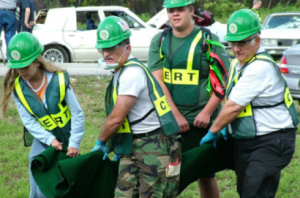CERT stands for “Community Emergency Response Teams.” The program was first developed by the Los Angeles Fire Department in 1985 to train civilians and private or government employees to be able to help in case of earthquakes. It was successful, and in 1993 it was made available nationally. Since then, all states plus Puerto Rico, Guam, the Virgin Islands, American Samoa, and the Northern Mariana Islands have CERT programs. The Emergency Management Institute and the National Fire Academy adopted and expanded the CERT materials so that they now apply to all types of disasters, natural and man-made.

Emergency Essentials wants you to be prepared to help yourself. We also encourage you to get involved in your community and help those around you prepare. (We also sell
CERT gear, so once you're CERT-ified you can get everything you need.)
What is CERT’s present purpose?
CERT exists to educate people about disaster preparedness with particular attention to hazards that might exist in their area—and to train them in basic response skills, so that they can jump in and help until professional responders can get there. In any disaster, professional responders can be overwhelmed with calls for help, and their efforts are often complicated by blocked roadways, communications breakdowns, and the sheer number of injured people. People will need to help each other, and CERT is designed to prepare them to do just that.
Who conducts CERT training, and how is it given?
CERT teams, fire departments, emergency medical technicians, FEMA workers, or anyone who has been “CERTified” can provide the training from approved materials. The training is given in seven 2 ½-hour sessions, once a week, including classroom teaching as well as practical experience and drills. There are classes especially for teens, and online CERT classes as well.
Who can participate in CERT training?
Anyone who is interested can sign up to participate. The FAQ on FEMA's CERT page says, "Naturals for the training are neighborhood watch, community organizations, communities of faith, school staff, workplace employees, scouting organization and other groups that come together regularly for a common purpose. CERT skills are useful in disaster and everyday life events."
Check in your area to see if you think joining a CERT team would be a good fit for you.
What exactly is included in CERT training?
Following major disasters, volunteer rescue efforts can help save hundreds of lives. Sadly, it's also true that volunteers without adequate training have lost their own lives in their efforts to save someone else. Such a high price is preventable through training in proper emergency response—and that is one of the factors that CERT training addresses. CERT aims to:
- Train people in what to expect after various types of disasters
- Teach them their responsibilities in mitigating damage and preparing to help
- Train them in lifesaving skills, with emphasis on decision-making, rescuer safety, and on doing the greatest good for the greatest number
- Organize teams to be an extension of the corps of first responders, able to give immediate aid without doing harm to themselves or others until the professionals arrive.
What are the seven topics covered in the classes?
-
Disaster Preparedness (localized information) plus CERT concept and organization
- Disaster Fire Suppression
-
Disaster Medical Operations I—diagnosing and treating airway obstruction, bleeding, and shock
-
Disaster Medical Operations II—head-to-toe assessment, basic first-aid, sanitary procedures, and establishing a treatment area for the injured.
-
Light Search and Rescue Operations—planning, size-up, search techniques, rescue techniques, and rescuer safety
- Disaster Psychology and Team Organization
- Course Review and Disaster Simulation
Where can I learn more about CERT programs in my area?
Go to www.citizencorps.gov/cc/listCouncil. To start a CERT training program in your community, here are the steps:
- Identify the program goals that CERT will meet and see what resources are available to conduct the program in your area. (You will need trained responders to teach the course.)
- Gain approval from elected and appointed officials to conduct the training.
- Identify and recruit potential participants. Contact community groups, hospitals, business and industry workers, local government workers and church groups.
- Train a cadre of CERT instructors who are already first responders
- Conduct CERT sessions (the 7-week course)
- Offer CERT refresher courses, drills, and exercises to keep trained “graduates” on their toes.
To pique community interest in CERT, you can sponsor events such as picnics, barbecues, community clean-ups, simulated disaster drills, or a disaster education fair. Make the program as desirable and interesting as possible to encourage participation, and advertise widely.
CERT publishes an online national newsletter with tips and updated information. To search for CERT materials and information, go to www.citizencorps.gov. (Don’t confuse this with
www.US-Cert.gov, which stands for United States Computer Emergency Readiness Team (formed to improve our country’s cybersecurity!)
Source: www.citizencorps.gov
Image source:
FEMA News Photo

